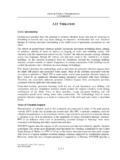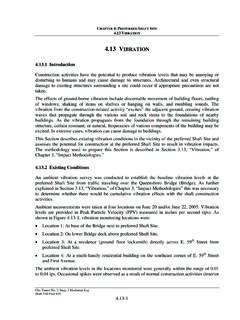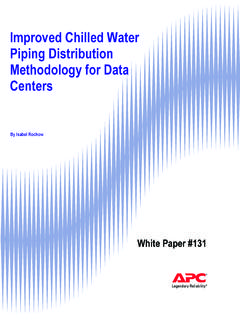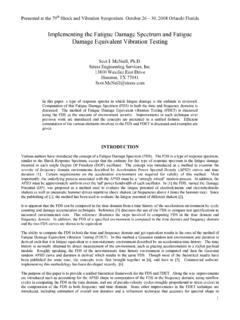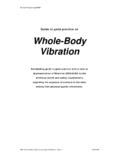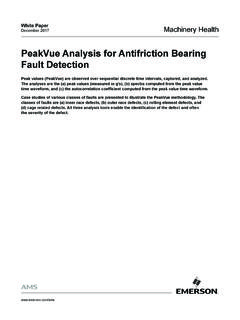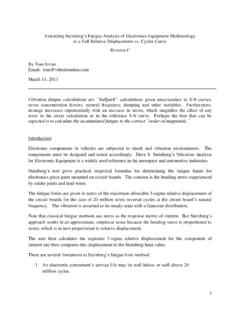Transcription of 3. Project Description and Methodology - Southampton VTS
1 Environmental Statement for Port of Southampton : Berth 201/202 Works updated by Further Information 23 3. Project Description and Methodology Project Description Berth Reconstruction The proposed works are designed to provide a deep-water berth at the container terminal capable of accommodating a 400m long, draught vessel alongside at all states of the tide. The existing quay construction at Berths 201 and 202 comprises a vertical sheet-pile wall tied to a reinforced concrete relieving platform, which is supported via steel bearing piles. The sheet piles extend to a level of approximately -20m Chart Datum (CD), with the associated bearing Executive Summary: Chapter 3.
2 Project Description and Methodology The proposed works are designed to provide a deep-water berth capable of accommodating a 400m long, draught vessel alongside the existing Berths 201 and 202 of the container terminal. To achieve this, it will be necessary to deepen the existing berths from depths of and Chart Datum (CD) to a new dredged depth of -16m CD. The existing quay structure is neither deep enough nor strong enough to permit the berth to be deepened, and consequently, a new quay wall will have to be constructed. Having considered the relative environmental impact and technical feasibility of a number of different methods of construction, it has been concluded that a steel combi-wall presents the best technically viable solution, without unacceptable navigational and environmental impacts, whilst being economically sound.
3 The steel piles will have to be installed using percussive pile driving techniques because of the size of piles required and the hard driving conditions known to exist in this location. The construction works are expected to commence in July 2010 2012 and will take approximately 14 months to complete. The quayside piling will be carried out between 16 September and 31 March to mitigate any potential impact on Atlantic salmon. It is anticipated that up to four piling rigs will be used for this activity although it is unlikely that all four rigs will be operational at the same time. Following completion of the quay wall, the berth pocket will be dredged. Approximately 182,000m3 of material, comprising a thin layer of soft sediment overlying stiff clay and dense sand, will be removed.
4 If no alternative beneficial use is found, the material will be disposed of at sea at the Nab Deposit Ground. Following the rebuilding of the quay wall and the dredging of the berth pocket, up to six ship to shore gantry cranes will be erected along the rebuilt quay. Environmental Statement for Port of Southampton : Berth 201/202 Works updated by Further Information 24 piles extending to deeper levels of circa -30m CD at Berth 201 and -20m CD at Berth 202. The current depths of the berth pockets are between and CD. A typical section through the existing quay is shown in Figure In order to accommodate vessels of draught, the existing berths will have to be deepened. The existing quay structure cannot, however, support any deepening of the berth pocket without significant engineering and piling works.
5 Deepening of the berth without engineering intervention would result in bending stresses in excess of the capacity of the existing sheet piles and would also significantly reduce the lateral restraint to the toe of the wall. This would lead to instability of the whole structure. Consequently, it is proposed to construct a new quay wall seaward of the existing wall over the length of the existing Berths 201/2. The new quay wall must be able to accommodate a maintained depth alongside of 16m (CD) with an additional allowance for over-dredge and scour protection. It is, therefore, proposed to construct a steel combi-wall 3-5m in front of the existing quay wall, which will result in the effective reclamation of a maximum of of land, all of which is within the subtidal area.
6 No intertidal will be lost directly as a result of the works. Granular fill material or concrete will be used to infill the gap between the new quay wall and the original quay wall. It is estimated that of the order of 25,000m of material will be required for this activity, which may originate from either a licensed aggregate site or as a beneficial use of material made available from other concurrent projects. Dredging Capital dredging to a depth of -16m CD will be required to deepen the existing berths in order to create a new berth pocket approximately 490m long by 60m wide. It is anticipated that dredging will be undertaken by a backhoe dredger and the excavated material will be loaded directly to barges.
7 The volume of material to be dredged is estimated to be in the order of 182,000m , comprising a thin layer of soft and silty sediments overlying stiff clay and greensand material. Disposal of Dredged Material Unless a beneficial use (see paragraphs to ) of the dredged material can be found, it is proposed to dispose of the material at the Nab Deposit Ground, located approximately 8 nautical miles east of the Isle of Wight (Figure ). The total, in situ, volume of dredge arisings will be disposed of over a period of around four weeks. The Nab Deposit Ground is used by both the Ports of Southampton and Portsmouth for current maintenance dredging and has been used for historical capital dredges, as well as smaller harbour and marina facilities around the Solent.
8 The disposal of material is covered in more detail in paragraph Landside Elements In addition to the above aspects, the berth 201/202 works also involve the provision of up to six Ship to Shore Gantry Cranes (SSGC) along the rebuilt berth quay, the relocation of lighting columns within the container storage yard area behind the quay, the relocation of a small electricity sub station and changes as necessary to the security fence around the Container Terminal. Environmental Statement for Port of Southampton : Berth 201/202 Works updated by Further Information 25 The SSGC to be provided along the rebuilt quay will be approximately 117 metres high above quay level with their boom up and approximately 85 metres high above quay level with their boom down.
9 This is the same as the largest cranes currently operating along berths 204 to 207. A row of 30 metre high lighting columns is currently located approximately 35 metres back from the edge of the berth 201/202 quayline. This row of lighting columns will be removed and replaced with a new row of similar columns approximately 70 metres back from the quay. This change is necessary to both provide a safe working area around the SSGCs and maintain the necessary level of lighting within the container stack area. A plan of the berth 201/202 works is provided at Figure Optimisation of Quay Wall Design In assessing the feasibility of different options of quay wall construction, it has been necessary to consider a variety of factors including environmental and navigation impacts, technical feasibility and commercial and economic factors.
10 ABP has appointed engineering consultants and contractors to advise on the most suitable engineering design and implementation techniques to minimise the impacts of the works. Alternative methods of quay wall design have been considered, taking into account known environmental impacts, such as noise and vibration. These include the following, which are discussed below: Utilising the Strength of the Existing Quay Wall; Cantilever and Anchored Sheet Piled Wall; Anchored High Modulus Wall; Suspended Quay; and Gravity Wall. Utilising the Strength of the Existing Quay Wall Investigations were undertaken to determine whether the existing quay wall could be utilised such that the new piles would act compositely with the existing structure.



